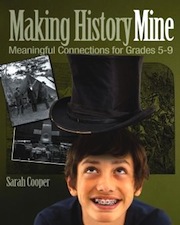10 Things I Learned Sitting in a Classroom
By Sarah Cooper
Last week I remembered how hard it can be to sit.
For five days, usually eight hours a day, I attended a seminar for history teachers filled with inspiring lectures and activities.
As fascinating as the content was, I learned almost as much about what it’s like to be a student as I did about the material itself. Most notably, I felt new empathy for having to follow teachers’ instructions all day long.
Here are 10 takeaways I’m bringing back to school this fall.
1. Movement is important.
During class I volunteered to pass out papers simply to be able to get up. Sometimes I wanted to stand against the wall to listen to a lecture, but it seemed rude, so I didn’t. During many discussions I slipped out to use the restroom or get a drink of water. Afterward, I felt much more able to focus.
If I had been required to ask the teacher if I could leave the room, I probably wouldn’t have, because I wouldn’t have wanted to seem like I was interrupting or didn’t care.
2. Letting students assuage their worries can help them learn.
Sometimes a student will ask to call or text his or her parents just before class starts, to confirm that day’s pickup or respond to a question that feels like an emergency. I’m not always sympathetic to these requests, wondering if the call could be made at break or lunch instead.
However, after sitting for a week in someone else’s class, I’m much more understanding.
One afternoon my phone was charging on the side of the room. During that afternoon’s lecture I worried that I would forget the phone and not be able to call my family that night. Being an adult, I walked over and got the phone. If I were a kid in a classroom with strict rules, I might feel it was difficult to do that. Then the phone would be competing with class in my mind, and I would feel less in control and likely learn less.
3. Social learning is real learning.
Often I’ll ask kids to pair-and-share, to chat for a few minutes about a concept before we return to class discussion. Through such check-ins, students release energy and explore their ideas.
At the seminar, I craved and appreciated such brief conversations. The material was so interesting that I wanted to talk about it, not necessarily in a large group but with my seatmate and other colleagues. I’ll be even more attentive to pairing-and-sharing now.
4. Student chatter is not always off-topic.
Of course, sometimes students are talking about the soccer game this afternoon or the party last night.
But sometimes they talk because they are burning to tell someone about an idea related to class. Last week I learned so much about film possibilities and lesson strategies from the woman sitting next to me.
If student conversations become wild, we can always return to pair-and-share for a minute or two – “Share with your partner anything you want to say about what we’re discussing” – or take a one-minute stretch break so that those who want can keep discussing the material.
5. Wandering the room can build connections, not just keep students on task.
When students are working in pairs or groups, I roam from desk to desk to answer questions and make sure everyone is working. However, last week I realized that such wandering also can acknowledge students’ ideas in a quiet and affirming way. Those who might feel overly enthusiastic sharing their thoughts with a large group might find a 30-second conversation with a teacher the perfect outlet. I did.
6. Writing about something helps cement it in your brain.
By the end of each day in class, my brain felt saturated.
Ideally we hope that our students will go home and reflect on their own. But many of them lack the time or inclination to do this, and their on-the-spot reactions can be powerful.
Writing a brief five-minute reflection – even as simple as “What is your reaction to this set of facts or this video clip?” – means that students can live inside their heads for a while and find their own perspectives. We as teachers can also glance at several responses to see where to head next in the class discussion.
7. Just because a student is quiet doesn’t mean he or she is not engaged.
In an ideal classroom, from the teacher’s perspective, students would be jumping off the walls to participate – and, in middle school classrooms, such enthusiasm is often a big reason we love teaching this freewheeling age group.
However, not all students will be able to rifle through information, especially heavy or charged content, and spit back a synthesis immediately. During my summer symposium, sometimes I was quietest in class when I was thinking the most.
8. Cold-calling can be kind, not cruel.
About half of the teachers in the seminar never said anything in class discussion. At times I wished the professors would call on these quieter students so that we could hear their voices. Ideally they would contribute on their own, but sometimes it was hard to break in when many others raised their hands. Cold-calling would have created an even more robust community by making elbow room for the less assertive learners.
9. Looking up relevant facts can help some students learn and be engaged.
During the lectures when the wireless was working, I took notes and looked up the speaker’s references online simultaneously. My seatmate often glanced over my shoulder at the works of an artist or author I had just found. Now, I remember those lectures even more vividly than the others because I was able to enhance them through my own curiosity (and device).
In 1:1 laptop and BYOD classrooms, one of the biggest challenges for teachers is that students distract themselves with irrelevant material. Giving students the freedom to search while we are talking takes balance and courage. But we shouldn’t be afraid to open the walls of our classroom to the quick fact check – with guidelines – when such exploration might engage students more.
10. You never know whom you are influencing, and how much.
Throughout the week we listened to one phenomenal lecture and Q&A session after another, but I didn’t usually thank the speaker afterward. The one time I did, I felt a little like a groupie or teacher’s pet. The words didn’t come out right – they were more effusive and less precise than I intended.
Better indicators of my interest were the intensity with which I was taking notes and the kinds of questions I asked.
For instance, in a lecture capping off our week, the professor quoted James Baldwin as saying in an interview with the oral historian Studs Terkel: “You read something which you thought only happened to you, and you discover that it happened 100 years ago to Dostoyevsky. This is a very great liberation for the suffering, struggling person, who always thinks that he is alone. This is why art is important. Art would not be important if life were not important, and life is important.”
The professor interpreted this quote to mean that “having a sense of history means knowing you’re not alone.” I was so excited by this this idea that, after looking up several other Baldwin quotations, I raised my hand to ask how much the professor thought literature was a valid source in writing about historical memory.
Back in my classroom . . .
Sitting in a desk for a week reminded me just how much control we as teachers have over students’ day-to-day lives in our classrooms.
As a result, I’m inspired to test just how much more independence I can give my eighth graders so that they feel more in control of classroom life – ideally learning more about themselves and about “having a sense of history” in the process.
Were you a student this summer? What did you learn?











































Great piece, Sarah! I especially appreciated the nuance you brought in looking at your experience as an adult, different in many ways from that of kids. My learning this summer has mostly been through Twitter, blogs, and online forums, so I don’t have anything to add in that sense.
I tell my students they don’t have to ask to leave the room. If they ask how I’ll know they’re not abusing it, I tell them that I trust them but if someone should begin to leave for long periods of time every day, I would sit down and talk to that person. Hopefully, that sends a positive message to them.
In my Humanities 7 classroom, kids design their own units and approximately 30-60 minutes of our 1’45” periods (yay double blocks!) are devoted to what we call “choice time” – a chance for kids to do any Humanities work they want on their own schedule, from research to free writes to free reading to working on a video with their friends to… whatever they can dream up. They love it.
Enjoyed this piece so much Sarah! These are powerful lessons from the classroom for students of any age. I especially liked your statement “My seatmate often glanced over my shoulder at the works of an artist or author I had just found. Now, I remember those lectures even more vividly than the others because I was able to enhance them through my own curiosity (and device).” As an arts educator you pointed out exactly what I often share with classroom teachers that visual and musical cues that connect students to core content have a “stickiness” and help students authenticate and personalize the material they are studying. Tapping into that external source at the moment that you were ready to seek it out is also key to developing a student’s sense of mastery. Thanks!
Thanks, Bill! Your “choice time” sounds fascinating. Do you check in with the students and keep track of what they’re up to? What kind of research and writing have they ended up doing?
Thanks! I do check in with the students – first with those who’ve asked to see me, second with those who I’m most worried about, and third about the rest. I mostly have them write in essay format; part of what I teach them is how to figure out what their thesis is, how many main ideas they have to support it (and what evidence they have to support those main ideas), and thus how many paragraphs they should have. Topics have been all over the place: animal cruelty, fashion in the middle ages, the effects of Title IX on girls athletics, determining whether Korea or Japan has sovereignty over the island of Dokdo, media depictions of women, human psychology and stereotypes, root values underlying different decisions on ethical questions, and, oh, hundreds more! I truly love seeing what they come up with.
Bill, these check-ins and topics sound wonderful!
And Marshall, I love your arts perspective here. The idea of “developing a sense of mastery” is a wonderful way of putting it. Thank you!
Thanks Sarah for this piece! I’ve started my graduate program at USC this summer and am in class 4 days a week. Your thoughts are spot on track and I’ve found new empathy for the students I had worked with in the past as well as my daughters. Pair-sharing and the professor checking in with us really helps process the information as well as allows me to personally connect on a quieter level. I see more clearly now how we, as adult learners, have the confidence to excuse ourselves for a moment in order to refocus, and being mindful of that same need in children is important. Thanks again- sounds like you had a great experience!
Terrific insight! These revelations can almost span 1-12. Thanks for sharing. They made me think again.
Thanks, Laurie! They might even help me with my own sons at home, too, grades 1 and 5.
Michelle, congratulations on starting your graduate program! What’s your focus? Glad to hear about the useful pair-sharing and check-ins by the teacher, and thanks for communicating that this these ideas can be useful for other adult as well as student learners.
Thanks for sharing. This has prompted me to make a few changes in my classroom.
Thanks, Shanell! I’d be interested to hear how they go and what grade level you teach.
Several years ago I undertook a little action research which involved observing a student for a day as they followed their timetable. The result was a very stressed learner as lesson after lesson and teacher after teacher ignored their learning needs. I am not saying this was intentional and I think the above article demonstrates how easy it is to forget what it is like to be a learner.
The first outcome from this is an e-book called “Understanding Learning Needs” (available from http://www.ace-d.co.uk). The second outcome has been four years of research and reflecting resulting in a concept I call “Learning Intelligence” or “LQ”. Simply put this is the ability of the learner to manage their learning environment to meet their learning needs. I have written expensively about LQ on my blog (4c3d.wordpress.com – link to original article is at:http://wp.me/p2LphS-3p ). LQ is a construct and involves a number of skills, attitudes, attributes and behaviours the learner is able to develop. I produced an info graphic for those who want a more visual introduction to LQ. It is at: https://magic.piktochart.com/output/2297869-learning-intelligence
My work has also included testing out the concept in practical teaching situations, developing a coaching model and center for literacy and numeracy and delivering workshops on understanding the needs of learners. The results show understanding LQ as a teacher and developing LQ as a learner makes a significant difference to the learning experience and achievement.
Questions and comments always welcome.
LQ is a fascinating idea – thanks for sharing it! We have encouraged teachers to do a “shadow day” of a student to see what it feels like. They are always impressed by how much our students do and pay attention to in a typical day.
This is so on target. I have been a teacher (elementary and middle schools as well as a college supervisor of student teachers) but ALWAYS a TEACHER, since the fall of 1955 and now am fortunate to be able to volunteer at Aldo Leopold Community School, a public school pre-K to 8 and best kept secret in Green Bay, WI. One of the impressive things “we” do for sharing student achievement is have the children prepare for and lead the student-parent conferences with the teacher present.
In a pre-conference meeting the student and teacher review the portfolio content and choose the materials that best show the progress being made. The student also reviews goals he/she has written previously to evaluate his/her own success and shares new goals for the next marking period or beginning of a new school year. It is a joy to see the enthusiastic response of all involved, as this is such a meaningful way for the child to be involved in his or her learning and provides another meaningful motivational technique.
Note: I have been in fifth grade for five years, the children ask why I can’t get to sixth grade, and my answer is: “I still don’t know my times-tables!”
Donald R Vineburg, August 4, 2014
Donald, I am in awe of your experience and glad to hear you’re teaching fifth grade. It has always seemed like such an exciting age for growth, even more so now that my older son is starting it next week. I’ve talked with and seen other teachers do student-led conferences, and I’m inspired to hear about your success with them. Thanks for the nice feedback, and have fun teaching this fall!
Love this, Sarah. So nice to see such insights from you!
Thank you, Patti!